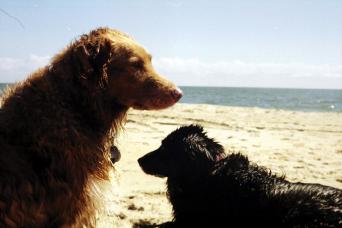
Bonding with Your Dog Through Nurture & Play

(Third of three parts.)
This is the last of my three articles about helping your dog learn how to cooperate with you, their human. Like people, our canine companions are much easier to teach when they appreciate their life and when their anxiety is minimized.
In my first article (June), I began by discussing the basic canine need for free-run exercise and covered the “recall” — teaching your dog to come when called. The premise is that our dogs’ happiness relies upon having the freedom to run and smell, and because they are intrinsically loyal creatures who are dependent on us, we can use focus and reward to ease their distractions and fears so that they learn to work with us.
My second article (July) was a primer in setting boundaries. It introduced the feeding process and how to use the “sit” and “wait” commands to teach your dog to acknowledge you as the human alpha. I also discussed the distinction among different voices — COMMAND, CORRECTIVE and PLAY/NURTURE — and that’s where I pick up here.
The COMMAND and CORRECTIVE voices are frequently used synonymously, but dogs hear them differently. For example, if your dog is in your way and you tell her in a corrective tone, “Get out of the way!” she hears an angry human and reacts with stress or even fear. Alternatively, if you use your dog’s name or an endearing nickname and say in a command tone, “Move, Cajun!” your voice keeps the dog focused on your expectation. Even if he’s not sure what you want him to do, he knows you’re asking him to do something.
The PLAY/NURTURE voice is not the one to use if you’re trying to get your dog to do something. (That’s tantamount to a bribe!) For example, if you use a nurture voice to call and offer your dog a treat because you want to entice her into a bath, you will generate distrust. If you want your dog to respond to the best of her ability, she needs to trust you; trust means your dog can read you clearly, and a dog can’t do that when your message is confusing.
REWARDS are a form of nurturing, and there three basic types: physical, verbal and food. Physical rewards can include a massage (which is as appreciated and healthful for canines as it is for people), tug-of-war and even lying over your dog as if to shelter her. Your voice should be your version of a comforting tone and serves as a verbal reward.
You should also offer food treats when your dog is being especially focused or when you want to give her some quality attention, not just as a reward for doing a trick or task. You want to reinforce your appreciation of her focus on your wishes.
Which brings us to the PLAY aspect of a happy dog. We bond with our dogs through play and can even help them recover from trauma — perhaps akin to what play therapy can accomplish with children. Dogs, even purebreds of the same breed, have their own unique personalities. Some are reserved and not particularly playful. Successful bonding with your dog requires a good match and observation of their personalities, just as it does with people.
As you would with a child, share experiences and spend quality time with your canine companion. Play is discovery; here are some personal anecdotes:
Cajun is a flat-coated retriever mix. As he was a rescue from Hurricane Katrina — he’s now 16 years old — I wanted to see whether his innate inclination to enjoy water had been compromised. (Some months after he arrived, watching “When the Levees Broke,” Spike Lee’s three-part documentary on Katrina, I actually spotted Cajun himself swimming at roof level!) Sure enough, Cajun would only wade in shallow local watering holes — if his feet couldn’t touch bottom, he backed out.
So I took him to the beach. He liked walking with me in the water and (on a long lead) followed my cues to feel safe in the waves, which were new to him. But he would start to panic if the wave required him to swim — until he realized that the life jacket I’d put on him kept him from sinking. Then he swam confidently, happily retrieving objects from the surf. Discovery!
Skeeter, according to the rescue group, is a runaway border-collie mix from Tennessee, where he was a gun dog used in duck hunting. Skeeter was terrified of noises, cars, stairs and new places. He’d also bolt like a rabbit whenever he could from wherever he could. Opinions from trainers I consulted were that because of his background and breed, it was unlikely I’d ever be able to trust him off leash. So I tried to think of ways to engage him and get him some exercise anyway.
I started with the long training lead and tried to find something to interest and distract him. First, in my fenced yard, I threw a ball with my friend’s golden retriever, Bear. Skeeter beat him to the ball every time and then dropped it near Bear, who then brought it back.
Then I started throwing a frisbee directly to Skeeter, standing a few feet away and using my most enticing play voice. Now he adeptly catches frisbees from any distance, often in midair. He loves it, feels a sense of accomplishment and gets a significant workout!
Create and discover what will float your dog’s boat, and he or she will keep you emotionally afloat with her loyal support.
Erick Redwood, M.Ed., does relationship counseling via cognitive behavioral therapy. He has adapted his methodology to facilitate understanding between canines and their humans. Email him at erick.redwood@gmail.com.
